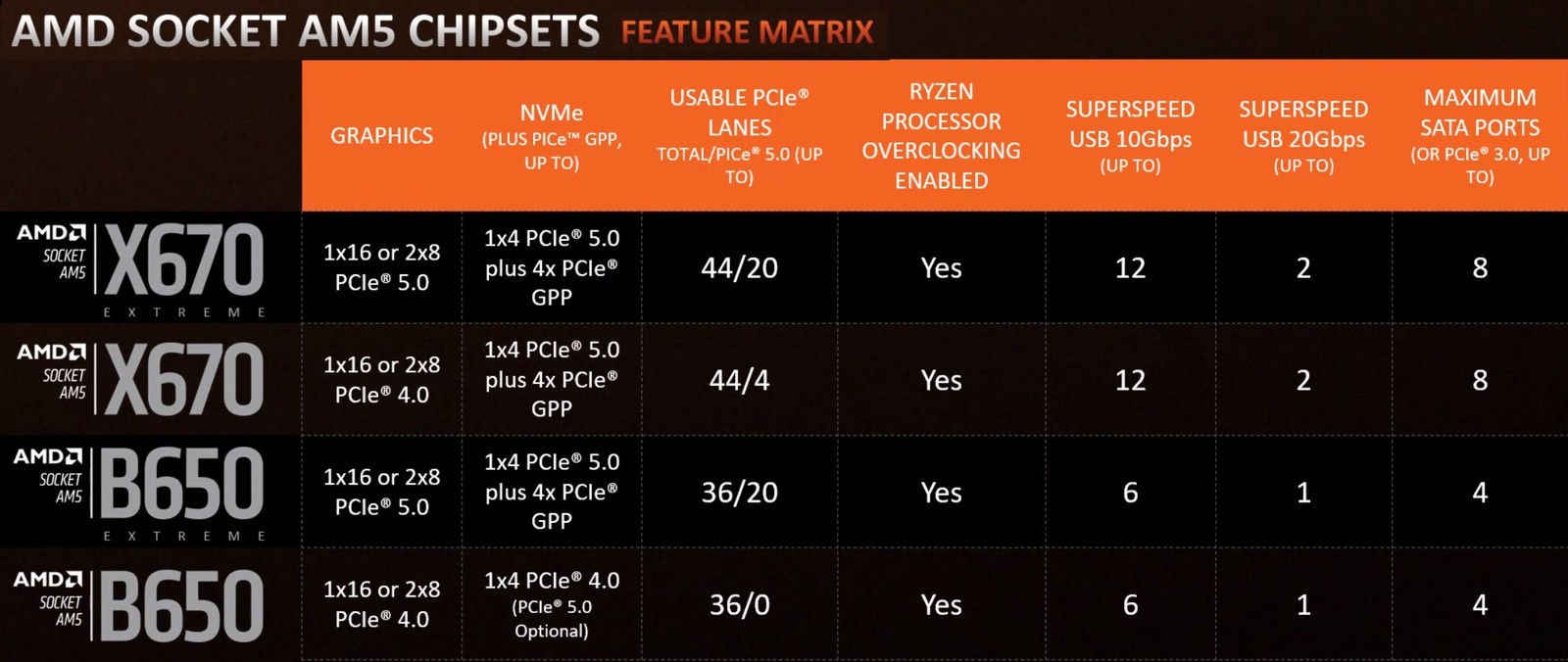Motherboards AMD B650, B650E, X670, X670E - what is the difference?

AMD B650 is the junior chipset of the first wave for socket AM5 motherboards and Ryzen 7000 processors, respectively. Only new DDR5 RAM is supported. Unlike Intel, which has retained backward compatibility with DDR4 for Core 12 and even 13th generation processors. However, the memory subsystem has always been a bottleneck for AMD processors, so a permanent transition to DDR5 seems like a logical decision. By itself, DDR5 starts at 4800 MHz, and the recommended frequency for the Ryzen 7000 is 5200 MHz. But most motherboards, even for the younger B650 chipset, allow you to overclock RAM over 6000 MHz.
 |
| Chipsets differ in the number and speed of PCIe lanes. |
AMD B650E - unlike the regular B650, the Extreme version, which is how the E index stands for, means support for the ultra-fast PCI-Express 5.0 bus. The M.2 SSD with four PCIe 5.0 lanes can reach up to 16 GB/s, while the 16 lane graphics cards can reach 64 GB/s. This is exactly twice as fast as PCIe 4.0, which supports the base B650 chipset without the E index. Another question is whether the average user already needs such a fast disk and video card, if it is quite comfortable to work and play even with the previous version of the PCIe 3.0 bus. But perhaps the GeForce RTX 4000-series and Radeon RX 7000 graphics cards will change the balance of power.

ASRock B650 Pro RS is a full-size ATX motherboard with socket AM5 for Ryzen 7000 processors. Supports DDR5 RAM, including ready-made EXPO one-button overclocking profiles. This is AMD's answer to competing XMP technology. The difference is that not only the main timings are recorded in the profile at the factory, but also additional sub-timings. This is because the high bandwidth of the memory subsystem is critical for Ryzen processors. And this is achieved by increasing the frequency only with a simultaneous decrease in timings and sub-timings, that is, delays. There is only one newfangled PCIe 5.0 slot - for M.2 SSDs, but immediately with a heatsink. Without it, it will certainly not be possible to cool the hot temper of ultra-fast PCIe 5.0 drives. The rear USB Type-C port is up to 10Gbps, but Gen 2x2 up to 20Gbps can be output to the front of the chassis.
AMD X670 - Similar to the old X570 chipset, the new X670 has more native PCIe lanes in addition to processor lanes. As a result, this chipset guarantees at least one fast M.2 PCIe 5.0 SSD slot. But the video card bus remains the old version of PCIe 4.0. It turns out that motherboards are more for workstations than for gaming PCs. Priority is given to the number, not the speed of connected devices: up to 8 SATA drives, and up to 12 USB peripherals. As a result, the X670 chipset seems to be the optimal main one for mid-price full-size ATX motherboards, where you can solder a lot, albeit not the fastest slots.

ASRock B650E PG Riptide WiFi is a motherboard with a 17-phase power subsystem based on SPS Dr.Mos high-ampere transistors. The printed circuit board is made of eight layers, which makes it resistant to extreme operating conditions: high temperature, humidity and electromagnetic field. The manufacturing company itself calls it a server class, which is close to the truth. The ultra-fast PCIe 5.0 interface, thanks to the Extreme modification of the chipset, is supported for both the video card and the SSD. There are three slots for M.2 drives in total, two are slower, but all are covered with aluminium coolers. The audio subsystem is represented by a 7.1-channel Realtek codec with Steelseries Nahimic software equalizer. And there are two network adapters at once: a wired Killer up to 2.5 Gbps and a wireless Wi-Fi 6E AX with a frequency of 6 GHz and Bluetooth in addition.
AMD X670E is the oldest chipset for the Ryzen 7000, which is a combination of two separate chipsets. Moreover, this is not a north and south bridge, as before, but two identical chipsets with twice the total number of PCIe 5.0 lanes. With it, you can assemble an NVLink bundle of two PCIe 5.0 video cards, and a RAID array of two PCIe 5.0 SSDs. There are also a small number of relatively slow PCIe 4.0 lanes, although I don't dare to call them slow. Most likely, motherboards with X670E will stand out with the widest overclocking functionality: Precision Boost Overdrive, Load-Line Calibration and EXPO.

ASRock X670E PG Lightning is a motherboard with the ability to overclock DDR5 RAM to 6600 MHz or even higher. Depends on the success of a particular memory kit and a particular RAM controller built into the central processor. It has three x16 video card slots, one of which is PCIe 5.0, and four M.2 slots for SSD. Another M.2 slot, but with an alternative Key-E pinout, is designed for wireless Internet Wi-Fi (the adapter itself is purchased separately). There are two video outputs for the RDNA 2 architecture graphics accelerator built into the processor: HDMI and Display Port. Considering that all Ryzen 7000 processors of the first wave received iGPU without fail, two video interfaces will obviously not be superfluous. Even if there is a discrete graphics card, you can activate the Dual Graphics mode to connect more monitors.
Articles, reviews, useful tips
All materials
































